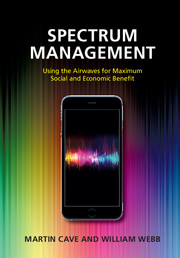Book contents
- Frontmatter
- Contents
- Preface
- Acknowledgments
- Plan of the book
- List of abbreviations
- Part I Fundamentals
- Part II Economic management of spectrum
- Part III Sharing and other emerging approaches to spectrum management
- Part IV Case studies and conclusions
- 11 The struggle for the UHF band
- 12 Public-sector spectrum use
- 13 Spectrum and the wider economy
- 14 Where next?
- About the authors
- Index
- References
11 - The struggle for the UHF band
from Part IV - Case studies and conclusions
Published online by Cambridge University Press: 05 November 2015
- Frontmatter
- Contents
- Preface
- Acknowledgments
- Plan of the book
- List of abbreviations
- Part I Fundamentals
- Part II Economic management of spectrum
- Part III Sharing and other emerging approaches to spectrum management
- Part IV Case studies and conclusions
- 11 The struggle for the UHF band
- 12 Public-sector spectrum use
- 13 Spectrum and the wider economy
- 14 Where next?
- About the authors
- Index
- References
Summary
The issues at stake
Territorial wars are seldom waged over infertile land, unless it has military or symbolic significance. The same is true of spectrum. Given the technologies available today, the most fertile spectrum lies below 3 GHz, and the very best of it is found in or just above the UHF TV band, which falls between 400 and 800 MHz.
This spectrum is particularly well suited both to terrestrial broadcasting and to mobile communications as a result of its propagation characteristics. At these frequencies radio signals travel many tens of kilometers, but equally receivers do not require antennas that are larger than handheld devices. In the case of broadcasting this allows most of a country to be served from a relatively small number of high-tower sites (e.g. around 100 for the entire UK). In the case of mobile communications the extended range is valuable both for covering rural areas and for achieving better in-building penetration than could be achieved at other frequencies.
In both cases, there are other options that can be used to enable service delivery. Broadcasting can be delivered using other spectrum bands or alternatively via non-spectrum inputs such as fibre-optic cables. TV distribution via satellite broadcasting uses spectrum in the 12 GHz range and this is much less valuable than the UHF band. Coaxial and fibre cables can be used to distribute TV content, which is increasingly the case in dense urban settings.
With regard to mobile communications there are many higher bands available – notably at 1,800 MHz, 2.1 GHz, 2.6 GHz and others. Voice and data services are also available for fixed and nomadic consumption by wireline technologies, combined with Wi-Fi final drop. But auction data show that the higher frequencies are much less valuable (see Chapter 5). Telecommunications regulators continue to regard (perhaps with decreasing conviction) fixed and mobile voice and data services as falling in different economic markets, because they are seen by users as being insufficiently substitutable for one to impose a constraint on the other.
- Type
- Chapter
- Information
- Spectrum ManagementUsing the Airwaves for Maximum Social and Economic Benefit, pp. 207 - 230Publisher: Cambridge University PressPrint publication year: 2015



